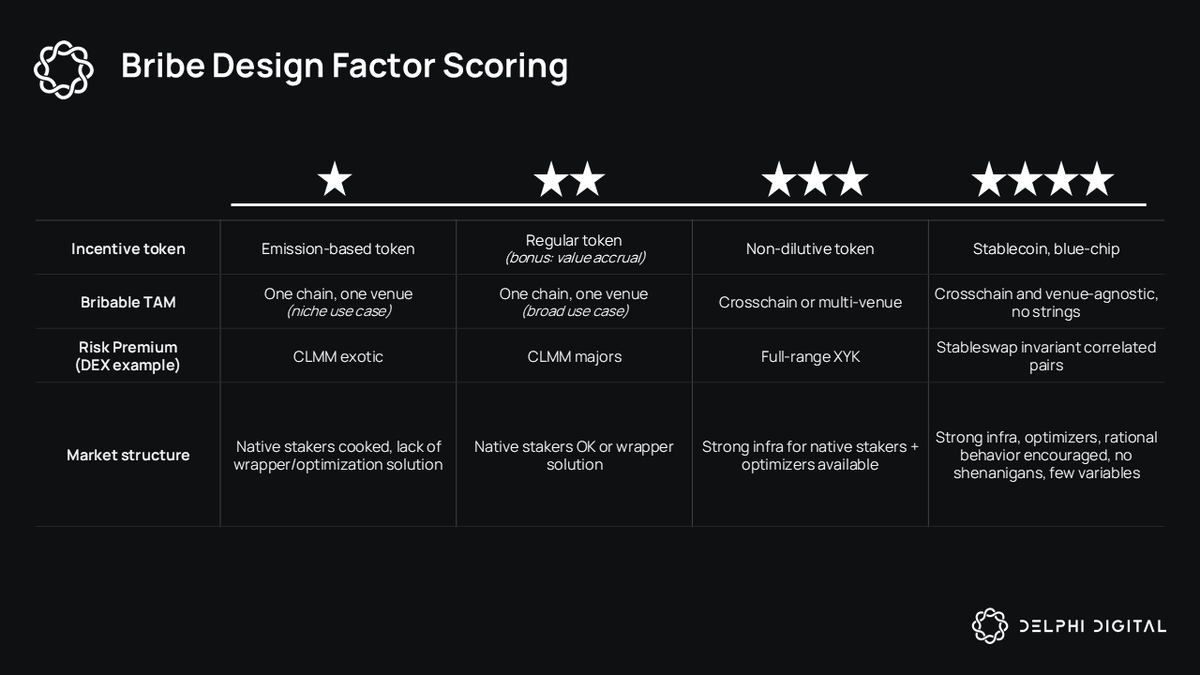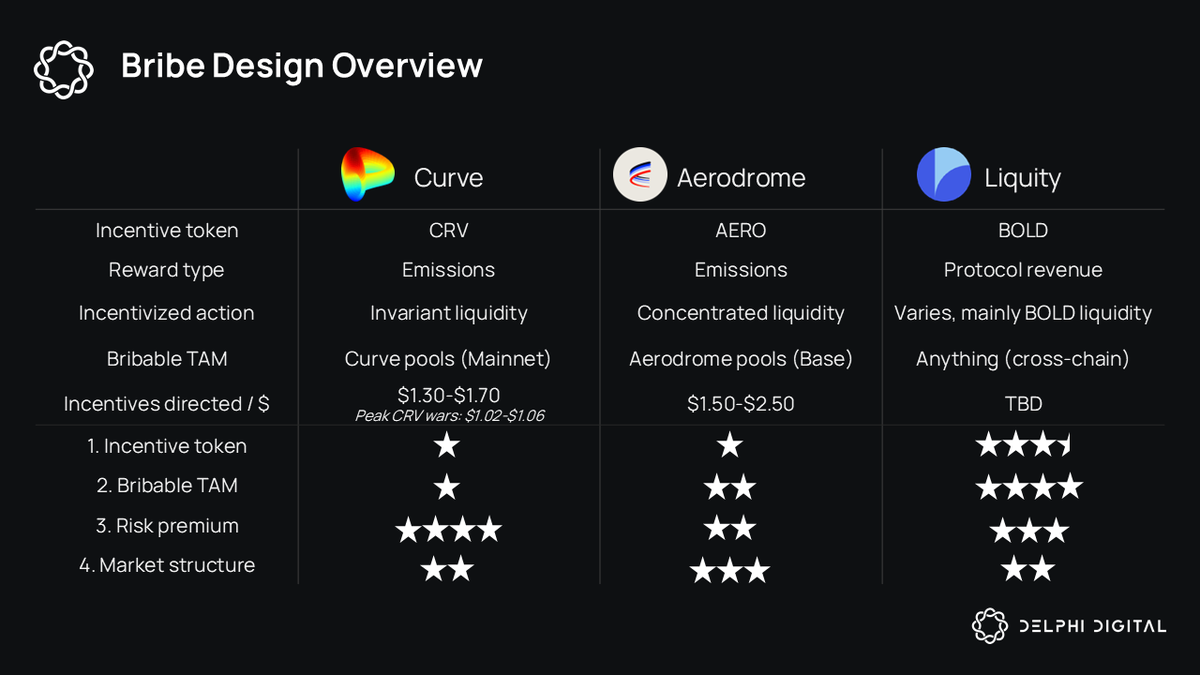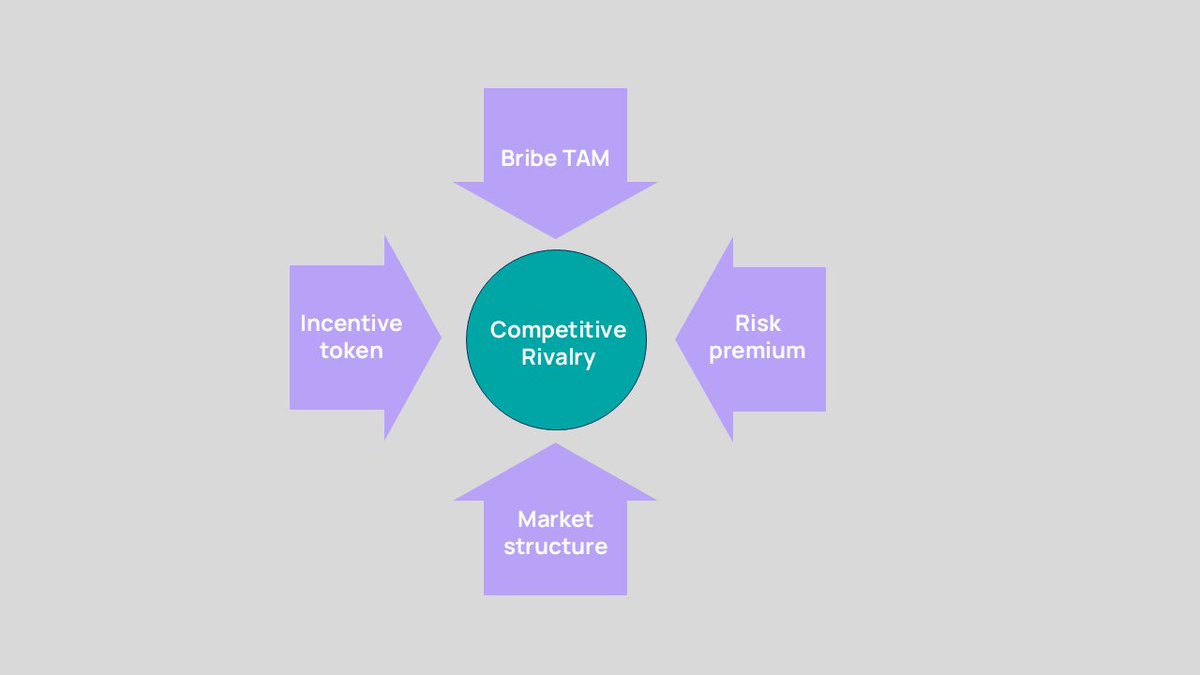Our analyst breaks down Liquity v2's bribe market and how BOLD incentives differ from traditional emissions.
Read the full analysis here.👇
Liquity v2 is quietly building the most efficient bribe market in crypto.
The bribe meta has been a fixture in DeFi with Curve, Aerodrome, and now Liquity v2.
However, bribe incentives come at the expense of token holders through inflationary rewards. This makes emissions-based bribe markets a net negative for token lockers.
Liquity solves this with protocol incentivized liquidity (PIL), directed by $LQTY stakers. Instead of using governance tokens as the reward token, Liquity rewards bribers with BOLD from protocol revenue instead.
This makes a big difference.
4 main factors contribute to the efficiency of a bribe economy:
1. Incentive token
2. Scope of bribable venues
3. Risk premium of incentivized action
4. Market structure
Let’s use Curve as an example.
1. Incentive token
The volatility and uncertainty of the incentive token may limit the market’s ability to price it properly. Bribers bid less to avoid overpaying, which leads to less bribes per dollar of incentives.
Incentivizing with an emissions-based governance token like CRV likely earns a lower multiple than a stablecoin (BOLD).
2. Scope of bribeable venues (TAM)
Curve’s bribe program is limited to Curve. This is necessary or things would get weird, but it places a ceiling on the TAM for bribes.
Liquity PIL is venue-agnostic. You can bribe across any chain & protocol. Any project incentivizing liquidity can pay LQTY stakers, get a small bonus, and distribute cold hard cash to users.
3. Risk premium
All liquidity mining campaigns must consider the yield threshold at which users are willing to leave lower-risk strategies like Curve 3Pool or Aave USDC. Bribe economies are not absolved from this process, but to see it we have to work backwards.
Consider a $100 bribe to a new Aerodrome pool. It receives X votes—let’s assume $150 worth. If the pool attracts $7.8K TVL for the epoch, that implies LPs require 100% APY for that pool. To increase the TVL, you will have to pay more to scale that APY for additional liquidity, and this risk premium will change with implied volatility.
The flipside of this is higher risk premiums often come with greater capital efficiency. While Aerodrome will typically earn less per dollar of emissions than Curve, its potential fees from these positions is higher, and projects need less TVL (and thus, less bribes) for the same goal.
BOLD’s wide array of potential incentive venues means the risk premium will vary, but it will generally involve liquidity for BOLD and is considered on the safer side.
4. Market structure
How does the token structure, vote bribing apparatus, program rules, and behavior of major entities facilitate or inhibit monetization of gauge votes? In other words, how cutthroat is the vote market?
As the first mover, Curve has a sloppy infrastructure for native lockers. Lack of native support for liquid wrappers and the bribe economy make monetization of vote power difficult. Aerodrome has robust tooling for lockers and bribers with its veNFTs & Relay feature. This strong setup is part of the reason why liquid wrappers for veAERO haven’t formed.
LQTY has native bribe support, but no liquid wrappers or optimization features.
There are other factors that influence the success of a bribe economy, but these factors highlight the fundamentals.
Liquity has nailed most of the bribe economy design, but still needs things to fall its way to achieve success. The friendly fork ecosystem seems to be the most likely path to achieving the elusive highly competitive BOLD wars narrative.



9.1K
9
The content on this page is provided by third parties. Unless otherwise stated, OKX is not the author of the cited article(s) and does not claim any copyright in the materials. The content is provided for informational purposes only and does not represent the views of OKX. It is not intended to be an endorsement of any kind and should not be considered investment advice or a solicitation to buy or sell digital assets. To the extent generative AI is utilized to provide summaries or other information, such AI generated content may be inaccurate or inconsistent. Please read the linked article for more details and information. OKX is not responsible for content hosted on third party sites. Digital asset holdings, including stablecoins and NFTs, involve a high degree of risk and can fluctuate greatly. You should carefully consider whether trading or holding digital assets is suitable for you in light of your financial condition.


